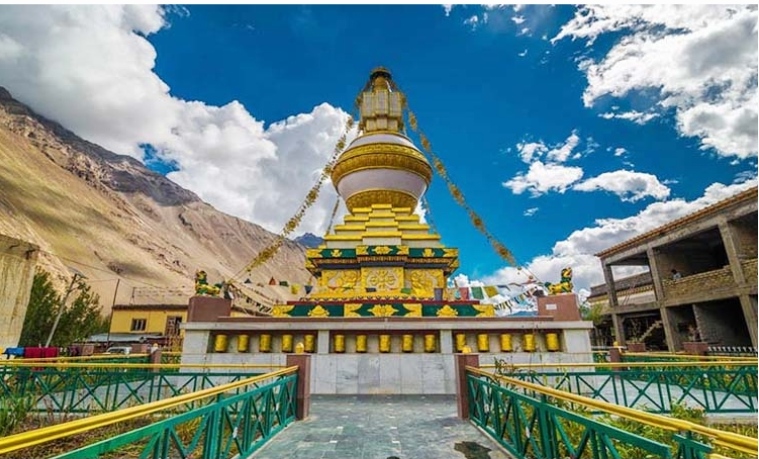Tabo Monastery : On route of wind & wool

By
Colonel Satish Singh Lalotra
Himalayas, the quintessential essence of mountaineering and allied activities combines far too many riches in its recesses, thrilling to no end anyone worth his salt to explore it in its entirety. Himalayas as a mountain range offer something beyond simply summiting a peak in record time or racing across an environment with barely a glance sideways. These Himalayas have hidden within themselves routes that touched the sun and sky and until very recently the only way to access some of the most isolated communities upon the high Tibetan plateau. What they left behind is a cultural tapestry of DNA, fusions of traditions and legacies of passageways that brought some of the world’s most luxurious fibers out of the desolate heights and into virtually every fabric market in central Asia. Economics, culture and natural elements were always bound inextricably to each other.
The year of 1996, was a specialty for me and my Tibetan soldiers who after having completed a roller coaster ride in the way of an operational tenure in the Central glacier of Siachen were now all set in the later half of 1996 to be placed in an equally challenging terrain littered with Tibetan mythology and culture, the Kinnaur valley of Himachal Pradesh bordering western Tibet. While at RN (Rest and refit) interlude at Leh I was approached by my company leader NimaTsering with a proposal which though slightly offbeat, I couldn’t say no to him keeping the sentiments of my Buddhist troops and the fact that they had successful tenure at Siachen and needed the much essential boost to their spiritual side too to maintain an even keel to their persona. NimaTsering came out with a proposal to let some selected but volunteers from the unit to visit Tabo Monastery which was celebrating its millennium foundation /1000 years of inception that year in 1996 followed by the much awaited ‘Kalchakra Sermonizing to be undertaken by the HH Dalai Lama the spiritual head of the Tibetans in the Spiti valley. Since the monastery, route more or less coincided with our new unit, location in Rupa valley of Kinnaurwhere we were headed for, I didn’t foresee anything amiss in terms of logistical backup to help facilitate our sojourn with these celebrations.
Having realized that the much talked about 15 days celebration of Tabo monastery commemorating its 1000 years of existence had already passed, I conferred with him to get the unit authorities convinced of his proposal and then proceed ahead. Anyway having got the go ahead, the party of 30 something with self and the company leader got delinked early on from the unit convoy in two vehicles hoping at least to partake in the blessings ceremony to be bestowed by HH Dalai Lama on the occasion of Kalchakra sermonizing. Entering the Spiti valley from the direction of Pooh in Kinnaur district we found it glittering as mica with hard blue skies and awesome views. What was clear was that the entire populace of Spiti valley spruced up in fine silks and turquoise was getting ready to rub shoulders at the desolate location of Tabo. I thought the event, millennium celebrations of the monastery followed up by Kalchakra sermons, a rite for peace in the troubled world by HH Dalai Lama would be a perfect balm for the bruised souls of my troops of SFF who along with me had just come down from the icy heights of Siachen glacier.
Tabo monastery the oldest and most important plus revered sites of Buddhist religion is a feast of ancient wall paintings and stucco structures.ln fact an estimated 30000 people, almost triple the size of Spiti population attended the first major social gathering in the recent past as per the memory of older generation of that area with whom we had the chance to talk to at length. Since the gates of Spiti valley opened in 1993, tourists have been coming here choc-a -bloc starting earlier in dribs and drabs. In fact all along the road from Pooh onwards to Tabo I could recollect now hanging of huge banners alongside the spiti river written in bilingual manner, English and Tibetan welcoming the Lamas and tourists alike to the millennium celebrations of the monastery which was being touted by the HP government as a coming of an age of Spiti, an exotic international event of the year 1996 that would catapult it into a major tourist destination.
Delve a little into the world Atlas, and Spiti sits forlorn between India and China – a desolate area that the locals of Himachal see with a wondrous eye.Spiti literally means ‘Middle lands.’, surrounded as it is by ancient kingdoms of Bushahr, Ladakh, Kullu and Tibet. Though a popular point in the central Asian trade route it has remained isolated because of the high mountain passes that surround it. In fact the close proximity of Spiti to the Chinese border has made the mandarins of both Defence and Home ministry at Delhi a bit wary in granting permission for such extravaganzas keeping the security aspect in mind. But for a diehard footloose and a wanderer no such restrictions can be a dampener. Even today Spiti valley lives like a severed limb of ancient Tibet frozen in time and space on a staple diet of barley, and tantric Buddhism that runs parallel to the daily lives of the locals and age old customs.
Since most of my Tibetan troops including self were still wearing the red coloured rice beads around our necks as Amulets, blessed by HH Dalai Lama while we were in the glacier, it was time to relinquish them and adorn new ones and what better ceremony to do it than the present Kalchakra ceremony presided by the holy man himself. It was a sheer coincidence or providence which I didn’t want to lose at all.The first thing which hit us when we reached the Tabo monastery were the huge multicolored tented colonies that had sprung up to cater for the deluge of lamas and tourists from all over the Buddhist world spanning from Japan in the far east to nearer home Nepal.Crowds of locals with a sprinkling of Caucasian featured spilled on to the lanes and by lanes of this forlorn place of earth. But the Tabo of the yore which I had conjured up in my mind for such a long time was nowhere to be seen. The so called Shangri-La of western Himalayas was churning fast yielding place to new order in thinking and action.Not to be disheartened, to see ochre- robed lamas with rosaries in one hand and coke or new mobiles in the other and sporting intricate pony tails convinced me to no end that the new world order was here to stay come what may.
It was a real shocker for most of my troops who as it were blindsided by their glacier tenure to see the locals making a fast buck at ‘Himalayan health food café’ at such a pious and momentous event which I remember was my first point of contact with the civilized world after deinduction.The café which was full of ageless hippies with doleful expressions drew deep into rolled cigarettes yearning for the ultimate hallucination reminded me of the iconic DevAnand movie of the 1970s ‘Hare Rama Hare Krishne.The mini entourage of ours was lucky enough to get to the tail end of the Kalchakra ceremony though having missed the main celebratory din of millennium celebrations of Tabo monastery. In brief the Kachakra ceremony requires initiates to practice various preliminary rituals before actually entering the main ‘Kalchakrayoga’. Its various preliminaries are refuge, awakening (Bodhichitta), Vajrasatva(meditation &recitation), f purification purposes, mandala offerings and finally ‘Guru yoga.. Having seen HH Dalai Lama bless all the congregants with his benevolent smile and a patience hearing was all that we wanted to absorb at this high altitude monastery.
Having removed our Amulets gifted to us by our unit lama at the base camp of Siachen we were again adorned with a fresh set of Amulets blessed by HH Dalai Lama and set out for our return journey to Rupa valley in Kinnaur district of HP.While going back we observed hordes of ochre-robed younger looking lamas who were a tad different from their earlier and older generation of lamas in myriad ways as stated above walking alongside Spiti river or just relaxing in the shades of rocks. The route to Tabo monastery falls on the world famous ‘Silk route’ where salt, tea, grains, trinkets and Pashmina wool have been the eternal magnets to draw world attention for centuries. Lene as Pashmina wool is known in these western part of Himalayas has remained an almost fashion statement and its soft warmth has been prized by the nobility across the globe. So much of Himalayan trade has been not about simply the exchange itself, but the relationships developed over the course of travelling the route, just like our small band from SFF did and coined this route as the route of ‘wind and wool’.



